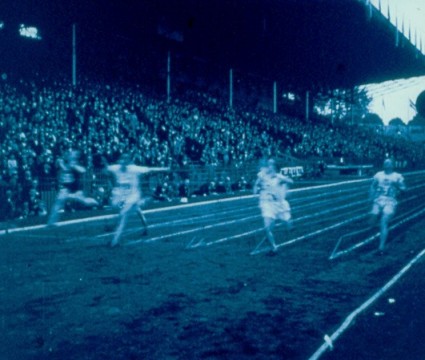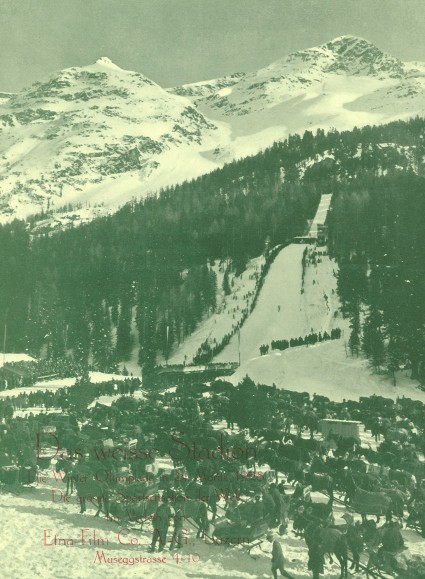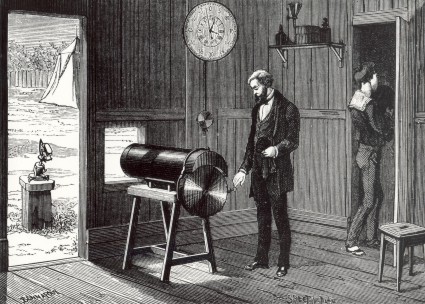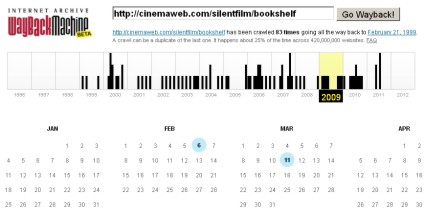Harold Abrahams winning the 100 metres, frame still from Les Jeux Olympiques Paris 1924
A month from now the London Olympic Games will begin. For two weeks hundreds of cameras will be trained on the athletes, images of whom will be beamed out to billions. The host broadcaster, the BBC, will provide over 2,500 hours of live coverage. Olympic Games footage will be receivable on TV sets, PCs, smart TVs, smart phones, on large screens in public spaces, and in 3D. The Olympic Games exists for our screens.
Perhaps nothing better illustrates the ubiquity, power and global shared experience that the motion picture has grown to represent from its simple beginnings in 1896 than that concentrated period, every four years, when it covers the Olympic Games, a phenomenon which likewise traces its (modern) roots to 1896. Four years ago the Bioscope produced a survey of the roots of Olympic moving image production, from the earliest years to 1928. We are reproducing that post, with revisions and new information, including recently discovered films, as our way of marking the forthcoming Games.
The modern Olympic Games and motion pictures share a common heritage, beyond that shared birthdate of 1896 (motion pictures existed before 1896, of course, but 1896 was when they first made their real impact upon the world). The two phenomena grew up together, in sophistication, intention and global reach. To view the films of the early Olympic Games is to witness the growth of the medium in how it captured action and form, from analysis, to (relatively) passive witness, to a medium that shaped athletic events to its own design. We see a transition from a formality bred of militaristic roots to entertainment, art and a focus on the individual. The survey that follows summarises the history of the Olympic Games on film throughout the silent era, that is, to 1928.
Athens, 1896
No one filmed the first Olympic Games of the modern era. The Games, which were held in Athens 6-15 April and attracted 241 athletes from fourteen nations, enjoyed some notice around the world, probably appealing as much to classicists as to athletes, but the motion picture industry was in its infancy and not as yet geared up to reporting on world news. Motion pictures had not yet reached Greece, America would only awake to motion pictures on a screen on 23 April, with the debut of the Edison Vitascope, and the Lumière brothers – really the only possible candidates – did not think to send one of their operators to Athens. Occasionally on television you will see film purporting to show the Games of 1896. Such scenes are false – in most cases, you are being shown images from 1906.
Paris, 1900
The 1900 Games were something of a disaster after the modest triumph of Athens. Organised to run alongside the great Paris Exhibition of 1900, the Games were barely recognised as such, being so chaotically organised and poorly promoted that many of the athletes who did take part in the events (which stretched from May-October 1900) were unaware that they had taken part in the Olympics. It is no surprise, therefore, than no standard films were made of Paris Games (several films of the Paris exhibition survive, but none show the athletic contests).
However, fleeting cinematographic records do exist. The Institut Marey, the scientific institute led by Etienne-Jules Marey, who had developed the art and science of chronophotography (sequence photography undertaken for the purposes of analysing motion), decided to record some of the visiting American athletes, to compare their methods with those of French athletes. Alvin Kraenzlein (winner of gold medals for long jump, 60 metres race, 110 metre hurdles and 200 metre hurdles), Richard Sheldon (illustrated, gold medal winner in the shot put), and the legendary Ray Ewry (exponent of the now discontinued events of standing high jump, long jump and triple jump) were among those recorded. The ‘films’ are a few frames long, lasting less than a second each, yet they were enough to demonstrate the superiority of the dynamic attack of the American technique over the correct military bearing of the equivalent French athletes. These fleeting images survive today – there are examples in the National Media Museum – and illustrations from them can be found in the official report on the Games.
St Louis, 1904
Paris was a disaster for the nascent Olympic movement, but St Louis was worse. Again, they went for the convenience of being part of a general Exposition, and again the Olympic events were mismanaged from start to finish, with little sense of a Games with a distinct identity, and the distant location putting off many athletes not hailing from America. Nor, to the best of my knowledge, were any films taken on the Games – certainly I’ve found no evidence from catalogues of the period of any such film being taken.
Athens, 1906
The 1906 unoffical Games were held at the same stadium in Athens as 1906. The above photograph (with close-up) shows a motion picture cameraman (possibly operating a Bioscope camera) filming the high jump. Image courtesy of http://www.sportsantiques.com
The intercalary Games of 1906 did not occur during an official Olympiad (i.e. the four-yearly period that marks when the Olympic Games are held), but this intermediary contest, designed partly as a sop to the Greeks who were disappointed that the Games were not being held permanently in Athens, was a relative success and did much to get the idea of the Olympics back on track. It also attracted the film companies. Gaumont and Pathé from France, the Warwick Trading Company from Britain, and Burton Holmes of America all made short films of the Games (we are long way yet from feature-length documentaries). Three one-reel films survive. Gaumont’s coverage held by the BFI concentrates on the opening ceremonies and gymnastic displays; recently discovered Pathé footage uncovered as part the Corrick Collection in Australia includes the opening and closing ceremonies, tug o’ war, hurdling, cycling, gymnastics), and medals ceremonies; the brief unidentified footage, also held by the BFI, shows the standing high jump.
London, 1908
Dorando Pietri finishing the 1908 Marathon (still photograph)
The Games started to come of age in London in 1908. Although they were again held in tandem with an exhibition, in this case the Franco-British Exhibition, for which the famous White City and associated stadium were built, this time the Games were welcomed by the organisers. The result was a popular success and a qualified triumph for sport – the qualification being necessary because the Games were marred by some bitter rivalry between America and Britain, geo-political tensions being played out on the athletics track not for the last time.
The Games were filmed by Pathé, in what seems to have been a semi-exclusive deal. The Charles Urban Trading Company filmed events outside the stadium, including the Marathon, but within the stadium it was Pathé alone, an indication of arrangements to come. Around ten minutes survive, a selection of which can be found on the British Pathe site, while the same footage is also held by the BFI. Basic coverage is given to the pole vault, high jump, tug o’ war, discus, water polo and women’s archery, though no names are given for athletes. But what distinguishes the 1908 coverage is the Marathon. Around half of the extant film of the Games is devoted to the race, concentrating on the Italian Dorando Pietri, who staggered over the line first, only to be disqualified because he had received help after he collapsed in the stadium within sight of the finishing line (something the film makes quite clear). For the first time on film we thrill at the sight of Olympic endeavour.
Stockholm, 1912
Montage of clips from the 1912 Stockholm Games, from the IOC’s YouTube channel
The Stockholm Games of 1912 were the most successful yet. Twenty-eight nations, 2,407 athletes (just forty-eight of them women), a triumph of organisation, and an event followed more eagerly around the world than ever before. Responsibility for filming the Games went to the A.B. Svensk –Amerikanska Film Kompaniet, which commissioned Pathé exclusively – apparently without controversy – to film a series of short newsfilms. All this footage survives in the archives of Sveriges Television. Now, at last, the athletes are named, and we get a sense of competition and achievement. In the first of two reels covering the Games held in the BFI National Archive, we see the inevitable gymnastic display, first by Scandinavian women’s team (for display purposes alone – women’s competitive Olympic gymnastics only began in 1928) followed by men’s team and individual gymnastics; the Swedish javelin thrower Eric Lemming, winner with the world’s first 60 metre throw; fencing, shot put, the 10,000 metres walk and the shot put, won by Harry Babcock of the USA. The second reel features men’s doubles tennis, the soccer tournament (Great Britain – not England – beating Denmark 4-2 in the final), Graeco-Roman wrestling, hammer throwing, the standing high jump, and the Marathon, run on an exhaustingly hot day that caused half the runners to retire. Filmed in engrossing detail, the drama of the Marathon is built up well, the tension in the sporting endeavour pushing forward the form of the film attempting to encapsulate it. The race was won by Kenneth McArthur of South Africa.
Antwerp, 1920
America’s Duke Kahanamoku, who later enjoyed a film career, winning the 100 metres freestyle at the 1920 Antwerp Games, from the IOC’s YouTube channel
The Sixth Olympiad was to have been held in Berlin in 1916. Those Games were, unsurprisingly, cancelled, though film exists of German athletes training for the Games. After the war, the Games were awarded to Belgium, which perhaps was not entirely ready for the compliment after all it had been through, and the 1920 Games were hastily and cheaply organised. Despite this, the growing world interest in athletic competition had continued to grow, and there were several notable athletes who made their mark on Olympic history, including the ‘Flying Finn’ Paavo Nurmi, America’s Charley Paddock winning the 100 metres, and France’s Suzanne Lenglen at the start of gaining worldwide fame as a tennis player. There is a tantalising suggestion in a New York Times article (28 Nov 1923) that an exclusive filming concession was organised for Antwerp, only to be overthrown before the Games because of protests from other film producers, but I have not been able to find confirmation of this nor discover which company was to have had the exclusive. But it is indication of growing American interest in the Games, and consequently increasing interest from the American media. Sadly, relatively few newsreels survive to show just some of the sporting events.
Paris + Chamonix, 1924
Photographers and cinematographers at the 1924 Olympic Games in Paris, from the official report, available at http://www.la84foundation.org
And then we come to 1924. The second Paris Games have become familiar to many through their recreation in the 1981 film Chariots of Fire. There is a particular thrill in seeing the two British athletes whose fortunes are covered by the Oscar-winning film, Eric Liddell and Harold Abrahams, turning up for real in such detail. This was the first Games to be covered in depth on film. The exclusive rights were granted to Rapid-Film of France. As reported for 1920, there was controversy over a single company being granted exclusive filming rights, with the Americans being particularly aggrieved, to the extent that their rugby team threatened to withdraw from its match with the French unless they were permitted to film it. The concession was granted (the USA amazingly won the match), but the episode highlighted the organising committee’s anxious search for additional revenue by selling exclusive rights, and the outrage this caused for those who believed the Games should not be anyone’s exclusive.
Though it could be conceived of as a single work, Rapid-Film’s Les Jeux Olympiques Paris 1924 was released in three parts in France (recreation of the Ancient Games, Summer, and the Winter Games held in Chamonix), and in the UK as a series of two-reelers dedicated to different sports. It was recently restored by the International Olympic Committee’s archives in its full length form, a daunting three-and-a-half hours long. There is too much about it that is drably routine, but individual events are never less than efficiently portrayed and occasionally marvellously so. Particularly thrilling is the football, where the Uruguyan gold medal winners demonstrate a level of tehnical accomplishment light years ahead of the sturdy endeavours of the European teams. The 100 metres, won by Abrahams, is a highlight, with choice details such as the athletes digging holes in the track for their heels. Slow motion is used artfully (particularly for the 3,000 metres steeplechase). The Marathon is a tour de force, a real drama in itself, with such carefully observed details as the anxious look of officials at the drinks stations (and how delightful in itself that the French served wine as well as water).
Star athletes on show include Nurmi, his great Finnish rival Ville Ritola, the Americans Jackson Scholz (sprinter) and Helen Wills (tennis player), but disappointingly all we see of the future Tarzan Johnny Weismuller is his submerged figure in long shot as he raced to fame as a swimmer. Les Jeux Olympiques Paris 1924 (produced by Jean de Rovera) is no film masterpiece, but as a sporting record, it captures greatness.
Amsterdam + St Moritz, 1928
The flying Finns Paavo Nurmi and Ville Ritola in the 5,000 metres (won by Ritola). The clip shows the 1928 film’s distinctive use of onscreen titles. From the IOC’s YouTube channel.
The last Olympic Games of the silent film era were held in Amsterdam (summer) and St Moritz (winter) in 1928. The Games were by now thoroughly established as an event of worldwide significance. The idea of a film dedicated to the Games had also been established, though the problems that beset the 1928 film of the summer Games, Olympische Spelen, were such that it was barely seen, and it remains little known. The history is complicated, but essentially in 1927 the Dutch Olympic Committee approached a federation of Dutch film businesses to manage the filming of the Games. Negotiations fell down over financial considerations – and because the Dutch commitee was, at the same time, negotiating with foreign film companies. A German company, Olympia-Film Ag, was originally awarded the contract, but heated objections were raised, OFA withdrew for financial reasons, and the committee ended up doing a deal with the Italian company Istituto Luce. For the first time a director was chosen with an ‘arthouse’ pedigree (Leni Riefenstahl’s Olympia of 1936 was neither the first Olympic film nor the first with a notable director, as some histories would have us believe). The director was the German Wilhem Prager, who had enjoyed notable success with the 1925 kulturfilme sports documentary Wege zu Kraft und Schönheit (Ways to Strength and Beauty), in which Riefenstahl takes a fleeting acting role.
Prager’s film (preserved in the EYE Film Institute in the Netherlands) is no more than efficient, though it does have some innovations such as having the names of athletes in some distance races appear as captions alongside them as they run. The film shows us Nurmi and Ritola once more; Boughera El Ouafi, the Algerian-born (but running for France) winner of the Marathon; the ebullient Lord Burghley (played by Nigel Havers in Chariots of Fire) winning the 200 metre hurdles; and Japan’s triple jumper Mikio Oda, the first Asian athlete to win an Olympic gold medal. But alas, owing to the considerable mishandling of the whole affair by the local Olympic Committee, Dutch exhibitors boycotted the official film, and hardly anyone saw it.
Advertisement for Das Weisse Stadion
There was also a feature-length film made of the 1928 Winter Olympics at St Mortiz, Das Weisse Stadion. Directed by Dr Arnold Fanck (the man who discovered Leni Riefenstahl as a film actress) and Othmar Gurtner, it was made by the same Olympia-Film as was scheduled to film the summer Games (the commercial failure of the film led OFA to break its contract to film in Amsterdam), and edited by the great Walter Ruttmann. Until recently it was considered a lost film, but happily a print was just recently discovered and will be screened this August at the Bonner Sommerkino silent film festival in Bonn, Germany. Reports indicate that it is a beautifully shot film whose rediscovery greatly enriches our Olympic film heritage.
Olympic drama
Charley Paddock tells us why sporting celebrities often flop when it comes to films, from Photoplay, August 1928
Finally, to complete the history, note must be made of those Olympic athletes of the silent era who went on to appear in fiction films once their fame had been established through sporting endeavour. Johnny Weissmuller, star of the 1924 and 1928 Games, of course went on to eternal fame as Tarzan. The American sprinting hero of 1920 and 1924, Charley Paddock, starred in Nine and Three-Fifths Seconds (1925), The Campus Flirt (1926), The College Hero (1927), High School Hero (1927), and (guess what) The Olympic Hero (1928). The Hawaiian swimmer Duke Kahanamoku was in five American Olympic teams between 1912 and 1932, but could also be seen swimming and acting in Adventure (1925), Lord Jim (1925), Old Ironsides (1926), Woman Wise (1928) and The Rescue (1929). Buster Crabbe, like Weissmuller a swimming champion in 1928, went on to become Flash Gordon, while Herman Brix (shot put silver in 1928) went on to become Tarzan and as Bruce Bennett starred in many films, including Treasure of the Sierre Madre. Jim Thorpe, for some the greatest Olympic athlete of them all, who won the pentathlon and decathlon in 1912 only to have his medals stripped from him when it was discovered he had earned money playing minor league baseball, played bit parts in numerous Westerns in the 1930s and was portrayed by Burt Lancaster in Jim Thorpe -All-American (1951).
Finding out more
There are few histories of Olympic film, and where these do exist they either get elementary facts wrong or assume that everything started in 1936 with Olympia. As the above should indicate, there was a rich history of Olympic filmmaking going back to 1900, and many of the innovations in Olympic film which we might associate with later times had been achieved before films gained sound. One exception is Taylor Downing’s recently republished Olympia, in the BFI Film Classics series, which has a brief but generally reliable history of Olympic film prior to 1936 (though he overlooks the Amsterdam 1928 film). My long article ‘Sport and the Silent Screen’ in Griffithiana 64 (October 1998) has much of the history recounted above, though I have now had the opportunity to correct some facts, and amend some opinions, in ‘Rituals and Records: The Films of the 1924 and 1928 Olympic Games‘, European Review, vol. 19 no. 4, 2011, made available here by kind permission of Cambridge University Press © 2011 Academia Europæa. An excellent study of the media rights issues surrounding the 1924 and 1928 Games is Mark Dyreson, ‘Selling Olympic pictures: The Commercial Wars between Host Cities and the American Media during the 1920s’ (Proceedings of the 7th International Symposiums for Olympic Research).
The best general book on the Olympic Games, by several miles, is David Wallechinsky and Janine Loukey’s regularly updated and republished The Complete Book of the Olympics, a sport-by-sport historical survey which also includes (if you look hard) information on the film careers of some Olympic athletes.
The easiest place to see some of the films is via the International Olympic Committee. Under the Olympic Games section of its official site there is a mini-history of each Games from 1896 (excluding 1906), and in each of these sub-sections at the bottom of the page there is a Photo Gallery which also contains some video clips. Most of the same clips can be found on the IOC’s YouTube channel. Regrettably there is some truly foul background music.
Information on the Olympic Games generally is all over the place, of course, but for the researcher particular attention should be drawn to the LA84 Foundation site, an astonishingly rich resource originally create to commemorate the 1984 Los Angeles Games but now providing free access to a vast range of digitised historical documents on all of the modern Games (including, for examples, the official reports).
And finally, to bring things up-to-date, a film that we’ve already featured on the Bioscope but which it seems appropriate to publish again here. It’s called Boy, it was sponsored by British Airways as part of its Great Britons initiative for the 2012 Olympic Games, and it is a modern silent film, of some poignancy.
(And yes I’ll be there. Athletics, handball, football and table tennis, since you ask)
My grateful thanks to Guido Convents, Carleton Hendricks, Robert Jacquier and Adrian Wood for help in writing this post.



















